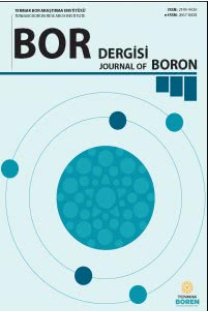Homojen çökeltme ile sentezlenmiş çinko borat ve span 60 içeren iğ yağından üretilen lubrikantlar
dört top testleri, homojen çökelme, lubrikantlar, nano tanecikler, Span 60, çinko borat
Lubricants having zinc borate by homogeneous precipitation and Span 60 in spindle oil
four ball tests, homogeneous precipitation, lubricants, nano particles, Span 60, Zinc borate,
___
- Gao, P. Q., Song, W. H, Wang X.(2013). Preparation and Characterization of Nano Zinc Borate/Epoxide Resin Composite. Key Engineering Material, 567, 87–90.
- Mergen, A., Ipek, Y., Bolek, H. , Oksuz, M.(2012) Production of nano zinc borate (4ZnO ·B2O3· H2O) and its effect on PVC. Journal of Europan Ceramic Society, 32, 2001-2005.
- Savrık, S.A., Balköse, D. , Ülkü, S. (2011) Synthesis of Zinc Borate by Inverse Emulsion Technique for Lubrication. Journal of Thermal Analysis and Calorimetry,104(201), 605–612.
- Li, S., Long, B., Wang, Z., Tian, Y., Zheng, Y., Zhang, Q. (2010) Synthesis of hydrophobic zinc borate nanoflakes and its effect on flame retardant properties of polyethylene. Journal of Solid State Chemisty,183, 957-962.
- Saffari, H.R.M., Soltani, R., Alaei ,M., Soleymani, M.(2018) Tribological properties of water-based drilling fluids with borate nanoparticles as lubricant additives, Journal of Petroleum Science and Engineering, 171, 253-259.
- Ipek, Y., Effect of surfactant types on particle size and morphology of flame retardant zinc borate powder, Turkish Journal of Chemistry, 44, 214–223, 2020.
- Baltacı B.(2010) Synthesis and Characterizatıon of Nano Zinc Borate and Its Usage as A Flame Retardant for Polymers [ M. Sc. thesis, Middle East Technical Universitiy]. Council of Higher Education Thesis Center (Thesis Number 286210)
- Baltaci, B., Cakal, G.O., Bayram,, G., Eroglu, I., Ozkar, S. (2013) .Surfactant modified zinc borate synthesis and its effect on the properties of PET. Powder Technology, 244,38-44.
- Cakal, G. O., Baltaci, B. , Bayram, G., Ozkar S., Eroglu, I.(2020) Synthesis of zinc borate using water soluble additives: Kinetics and product characterization. Journal of Crystal Growth, 533, 125461.
- Cui,Y., Liu, X., Tian, Y., Ding, N.,Wang, Z.(2012) Controllable synthesis of three kinds of zinc borates and flame retardant properties in polyurethane foam. Colloids and Surfaces A: Physicocheical and Engineering Aspects 414, 274– 280.
- Polat, S., Sayan, P.(2020) Box–Behnken experimental design for zinc borate Zn2B6O11·7H2O. Journal of Boron, 5 (3), 152 – 161.
- Gao, J., Yin, H., Wang, A., Jiang, T.(2013) Preparation of zinc borates with different structures and morphologies and their effect on thermal and oxidative stability of polyvinyl alcohol. Powder Technology, 237, 537–542.
- Durrani, H., Sharma, V., Bamboria, D., Shukla, A., Basak, S., Ali, W. (2020) Exploration of flame retardant efficacy of cellulosic fabric using in-situ synthesized zinc borate particles, Cellulose, 27, 9061–9073.
- Savrik, S. A., Alp, B., Ustun, F., Balköse, D. (2018)Nano zinc Borate as a lubricant additive. Journal of Turkish Chemical Society A, 5 ( 1), 45 – 52.
- Zhao, C., Jiao, Y., Chen, Y., Ren, G.(2014) The Tribological Properties of Zinc Borate Ultrafine Powder as a Lubricant Additive in Sunflower Oil. Tribology Transactions, 57, 425-434.
- Zhao, C. , Chen, Y.K., Jiao, Y., Loya, A., Ren, G.G.,(2014) The preparation and tribological properties of surface modified zinc borate ultrafine powder as a lubricant additive in liquid paraffin. Tribology International 70, 155–164.
- Ting, C., Deng, J. C., Shuo, W. L., Gang, F.(2009) Preparation and Characterization of Nano-Zinc Borate by a New Method. Journal of Materials Processing Technology, 209, 4076-4079.
- Savrik S. A.(2010) Enhancement of Tribologıcal Properties of Mineral Oil by Addition of Sorbitan Monostearate and Zinc Borate [PhD Thesis, İzmir Institute of Technology). Council of Higher Education Thesis Center (Thesis number 266584)
- Gao, Y. H., Liu, Z. H.(2009) Synthesis and Thermochemistry of Two Zinc Borates, Zn2B6O11∙7H2O and Zn3B10O18∙14H2O. Thermochimica Acta, 484, 27-31.
- Alp, B., Gonen, M., Savrık, S. A., Balkose, D., Ulku, S.(2012) Dehydration, Water Vapor Adsorption and Desorption Behavior of Zn[B3O3(OH)5] ·H2O and Zn[B3O4(OH)3]. Drying Technology, 30, 1610–1620.
- Moezzi, A., Lee, P., McDonagh, A.M., Michael, B., Cortie, M.B.(2020) On the thermal decomposition of zinc hydroxide nitrate, Zn5(OH)8(NO3)2⋅2H2O. Jourmal of Solid State Chemisty, 286, 121311.
- Schubert, D. M.(2019) Hydrated zinc borates and their industrial use. Molecules, 24, 2419.
- Briggs, M. (2001) Boron Oxides, Boric Acid, and Borates, in: Kirk-Othmer Encyclopedia of Chemical Technology, Wiley & Sons.
- Eltepe, H. E., Balkose, D., Ulku, S.(2007)Effect of temperature and time on zinc borate species formed from zinc oxide and boric acid in aqueous medium. Industrial and Engineering Chemistry and Research, 46, 2367-237.
- Zheng, Y., Tian, Y., Ma, H.,Qu, Y., Wang, Z. et al.(2009) Synthesis and Performance Study of Zinc Borate Nanowhiskers. Colloids and Surfaces A. 339,178-184.
- Dong, J.X., Hu, Z.S.(1998) A Study of the Anti-Wear and Friction-Reducing Properties of the Lubricant Additive, Nanometer Zinc Borate. Tribology International, 31, 219-223.
- Erdemir, A., Lubrication from Mixture of Boric Acid with Oils and Greases. U.S. Patent 5,431,830, 1995.
- Lingtong, K., Hua, H., Tianyou, W., Dinghai, H., Jianjian F.(2011) Synthesis and surface modification of the nanoscale cerium borate as lubricant additive. Journal of Rare Earths, 29, 1095-1099.
- Yu, H., Xu, Y., Shi, P., Xu, B., Wang, X.(2008) Tribological Properties and Lubricating Mechanisms of Cu Nanoparticles in Lubricant. Transactions of Nonferrous Metals Society of China, 18, 636-641.
- ISSN: 2149-9020
- Yayın Aralığı: 4
- Başlangıç: 2016
- Yayıncı: TENMAK Bor Araştırma Enstitüsü
Besleme suyu bileşiminin ve ön arıtmanın bora duyarlı mahsuller için sulama suyuna etkisi
Homojen çökeltme ile sentezlenmiş çinko borat ve span 60 içeren iğ yağından üretilen lubrikantlar
Sevdiye SAVRIK, Fatma Burcu ALP, Mehmet GÖNEN, Devrim BALKÖSE
Çeliklerin korozyonuna Boraksın Etkisi
Bor atıklarının farklı yüklü flokülantlarla ultrason destekli flokülasyonu
İsmail DEMİR, Can GÜNGÖREN, Yasin BAKTARHAN, Melike YÜCEL, İlgin KURŞUN, Kenan ÇİNKU, Şafak Gökhan ÖZKAN
Kalsiyum floroborat sentezi, kinetik ve alev geciktirici özelliklerinin belirlenmesi
Metin GÜRÜ, Gülden GÜNGÖR, Duygu YILMAZ AYDIN, Çetin ÇAKANYILDIRIM
